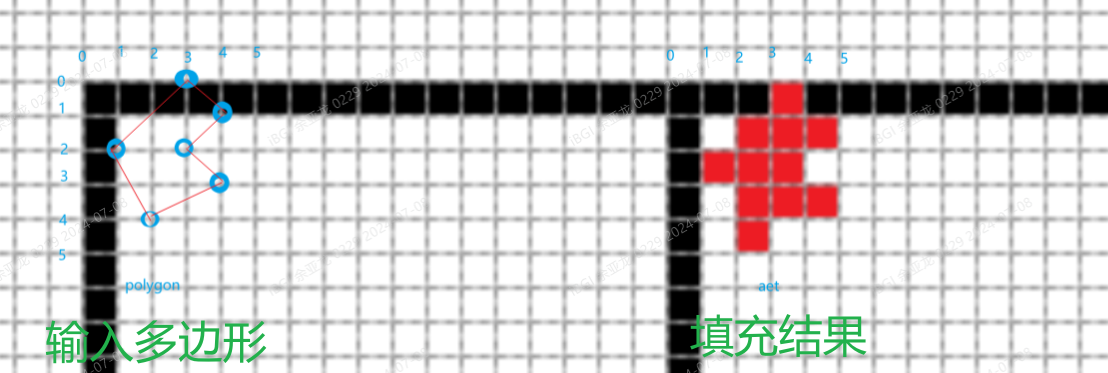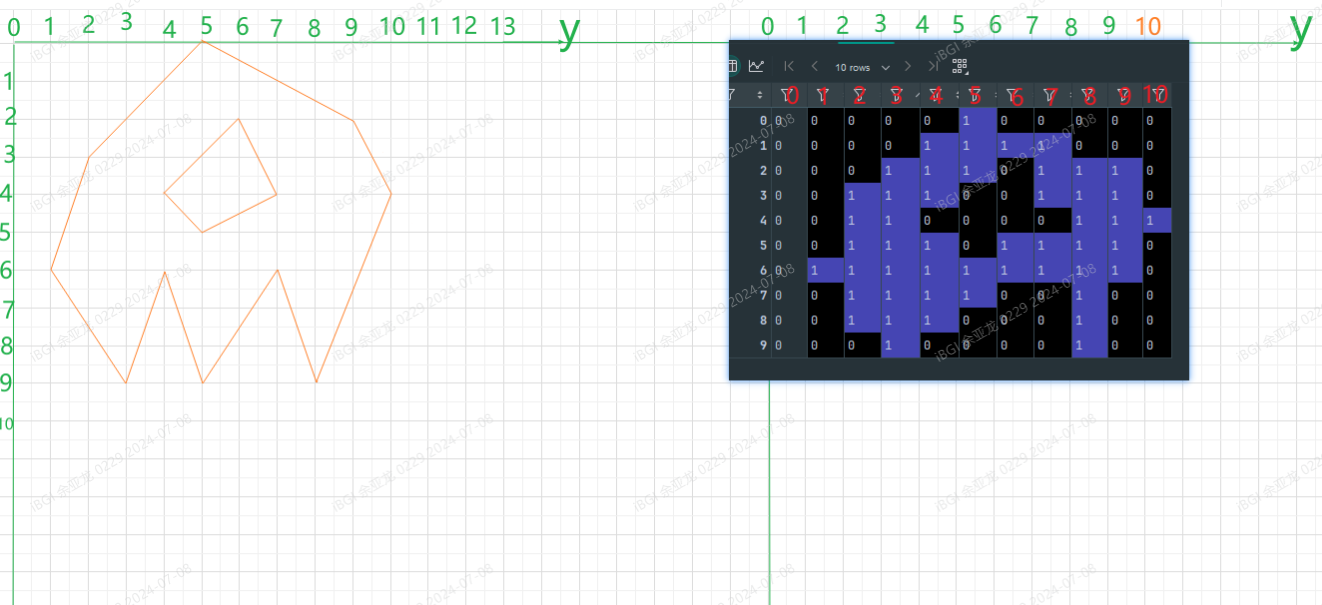多边形填充-活动边表法
参考文档:
参考1:https://blog.csdn.net/u013044116/article/details/49737585
参考2:https://blog.csdn.net/keneyr/article/details/83747501
算法思想:
对多边形沿y轴从0开始遍历,建立边表NET。只记录顶点的x, dx, ymax。
根据NET构建活动边表AET(activate edge table)。射线与多边形的交点坐标为(x + △x, y + 1), △x是斜率的倒数(dx)。详解见 参考1。
实现代码:
点击查看代码
# encoding=utf8
import math
import cv2
import numpy as np
class EdgeTable:
def __init__(self, x, dx, ymax):
self.x = x
self.dx = dx
self.ymax = ymax
self.next = None
def fill_polys(polys):
poly_x_max = float('-inf')
poly_y_max = float('-inf')
for poly in polys:
poly_x_max = max(poly_x_max, poly[0])
poly_y_max = max(poly_y_max, poly[1])
poly_x_max += 1
poly_y_max += 1
point_count = len(polys)
# build edge table
net = [None for _ in range(poly_y_max)]
for i in range(poly_y_max):
for j in range(point_count):
# 一个点跟前面的点形成线段 跟后边的点也形成线段
if polys[j][1] == i:
if polys[(j - 1 + point_count) % point_count][1] > polys[j][1]:
x_ = polys[j][0]
dx_ = (
polys[(j - 1 + point_count) % point_count][0] - polys[j][0]
) / (polys[(j - 1 + point_count) % point_count][1] - polys[j][1])
ymax_ = polys[(j - 1 + point_count) % point_count][1]
pnt = EdgeTable(x_, dx_, ymax_)
pnt.next = net[i]
net[i] = pnt
if polys[(j + 1 + point_count) % point_count][1] > polys[j][1]:
x_ = polys[j][0]
dx_ = (
polys[(j + 1 + point_count) % point_count][0] - polys[j][0]
) / (polys[(j + 1 + point_count) % point_count][1] - polys[j][1])
ymax_ = polys[(j + 1 + point_count) % point_count][1]
pnt = EdgeTable(x_, dx_, ymax_)
pnt.next = net[i]
net[i] = pnt
# build activate edge table
bg = np.zeros((poly_x_max, poly_y_max), dtype=np.uint8)
aet = EdgeTable(0, 0, 0)
for i in range(poly_y_max):
# 计算新的交点 更新aet表
pa = aet.next
while pa:
pa.x = pa.x + pa.dx
pa = pa.next
# 更新aet表之后对ate表进行排序
# 断表排序 不开辟新空间
pa = aet
pcur = aet.next
pa.next = None
while pcur:
while pa.next and pcur.x >= pa.next.x:
pa = pa.next
pt = pcur.next
pcur.next = pa.next
pa.next = pcur
pcur = pt
pa = aet
# net表中的点加入到aet表中,并用插值法按x排序插入
pn = net[i]
pa = aet
while pn:
while pa.next and pn.x >= pa.next.x:
pa = pa.next
pt = pn.next
pn.next = pa.next
pa.next = pn
pn = pt
pa = aet
# 填充
pcur = aet.next
while pcur and pcur.next:
# 浮点数转成整数 如果dx是负数 向下取整;如果dx是正数 向上取整
s = math.ceil(pcur.x) if pcur.dx > 0 else math.floor(pcur.x)
e = math.ceil(pcur.next.x) if pcur.next.dx > 0 else math.floor(pcur.next.x)
# for x in range(pcur.x, pcur.next.x+1):
for x in range(s, e + 1):
bg[x][i] = 1
pcur = pcur.next
# 从aet表中删除ymax==i的结点
pa = aet
pcur = pa.next
while pcur:
if pcur.ymax == i:
pa.next = pcur.next
del pcur
pcur = pa.next
else:
pcur = pcur.next
pa = pa.next
print(bg)
def matrix(polys):
m = np.zeros((10, 10), dtype=np.uint8)
for x, y in polys:
m[x, y] = 1
return m
def cv_fill(polys):
mask = np.zeros((5, 5), dtype=np.uint8)
cv2.fillPoly(mask, [np.array(polys)], 1, lineType=cv2.FILLED)
return mask
if __name__ == "__main__":
# r = matrix([[8, 8], [2, 7], [5, 5], [2, 2], [5, 1], [9, 3]])
# print(r)
polys = [[2, 4], [1, 2], [3, 0], [4, 1], [3, 2], [4, 3]]
fill_polys(polys)
# cv_fill(polys)
结果展示:

有空洞的情况:
点击查看代码
# encoding=utf8
import math
import cv2
import numpy as np
from collections import namedtuple
Point = namedtuple("Point", ["x", "y"])
# EdgeTable = namedtuple("EdgeTable", ["x", "dx", "ymax", "next"])
class EdgeTable:
def __init__(self, x, dx, ymax):
self.x = x
self.dx = dx
self.ymax = ymax
self.next = None
def fill_polys(polys, num=1):
poly_collection = []
each_poly_max_xy = []
each_poly_min_xy = []
poly_max_x = float("-inf")
poly_max_y = float("-inf")
for poly in polys:
points = []
max_x = float("-inf")
max_y = float("-inf")
min_x = float("inf")
min_y = float("inf")
for point in poly:
p = Point(*point)
points.append(p)
max_x = max(max_x, p.x)
max_y = max(max_y, p.y)
min_x = min(min_x, p.x)
min_y = min(min_y, p.y)
each_poly_max_xy.append(Point(max_x, max_y))
each_poly_min_xy.append(Point(min_x, min_y))
poly_max_x = max(poly_max_x, max_x)
poly_max_y = max(poly_max_y, max_y)
poly_collection.append(points)
poly_len_x = poly_max_x + 1
poly_len_y = poly_max_y + 1
bg = np.zeros((poly_len_x, poly_len_y), dtype=np.uint8)
# build edge table
count = -1
for poly in poly_collection:
count += 1
point_num = len(poly)
point_range_y = each_poly_max_xy[count].y + 1
net = [None] * point_range_y
for i in range(point_num):
# 一个点跟前面的点形成线段 跟后边的点也形成线段
before = (i-1+point_num) % point_num
after = (i+1+point_num) % point_num
for nbr in [before, after]:
if poly[nbr].y > poly[i].y:
x_ = poly[i].x
dx_ = (poly[nbr].x - poly[i].x) / (poly[nbr].y - poly[i].y)
ymax_ = poly[nbr].y
pnt = EdgeTable(x_, dx_, ymax_)
pnt.next = net[poly[i].y]
net[poly[i].y] = pnt
# build activate edge table
aet = EdgeTable(0, 0, 0)
for i in range(each_poly_min_xy[count].y, point_range_y):
# 计算新的交点 更新aet表
pa = aet.next
while pa:
pa.x = pa.x + pa.dx
pa = pa.next
# 更新aet表之后对ate表进行排序
# 断表排序 不开辟新空间
pa = aet
pcur = aet.next
pa.next = None
while pcur:
while pa.next and pcur.x >= pa.next.x:
pa = pa.next
pt = pcur.next
pcur.next = pa.next
pa.next = pcur
pcur = pt
pa = aet
# 从aet表中删除ymax==i的结点
pa = aet
pcur = pa.next
# 当 i==poly_y_max 时不删除,否则没法填充 y 最大时的顶点
# while pcur:
while pcur and i < each_poly_max_xy[count].y:
if pcur.ymax == i:
pa.next = pcur.next
del pcur
pcur = pa.next
else:
pcur = pcur.next
pa = pa.next
# net表中的点加入到aet表中,并用插值法按x排序插入
pn = net[i]
pa = aet
while pn:
while pa.next and pn.x >= pa.next.x:
pa = pa.next
pt = pn.next
pn.next = pa.next
pa.next = pn
pn = pt
pa = aet
# 填充
pcur = aet.next
while pcur and pcur.next:
# 浮点数转成整数 如果dx是负数 向下取整;如果dx是正数 向上取整
s = math.ceil(pcur.x) if pcur.dx > 0 else math.floor(pcur.x)
e = math.ceil(pcur.next.x) if pcur.next.dx > 0 else math.floor(pcur.next.x)
# for x in range(pcur.x, pcur.next.x+1):
for x in range(s, e + 1):
bg[x][i] = num - bg[x][i]
pcur = pcur.next
print(bg)
def cv_fill(polys):
mask = np.zeros((5, 5), dtype=np.uint8)
cv2.fillPoly(mask, [np.array(polys)], 1, lineType=cv2.FILLED)
return mask
if __name__ == "__main__":
# r = matrix([[8, 8], [2, 7], [5, 5], [2, 2], [5, 1], [9, 3]])
# print(r)
# origin
# polys = [[[2, 4], [1, 2], [3, 0], [4, 1], [3, 2], [4, 3]]]
polys = [
[
[0, 5],
[3, 2],
[6, 1],
[9, 3],
[6, 4],
[9, 3],
[6, 7],
[9, 8],
[4, 10],
[2, 9],
],
[[2, 6], [4, 4], [5, 5], [4, 7]],
]
fill_polys(polys)
# cv_fill(polys)
结果展示



